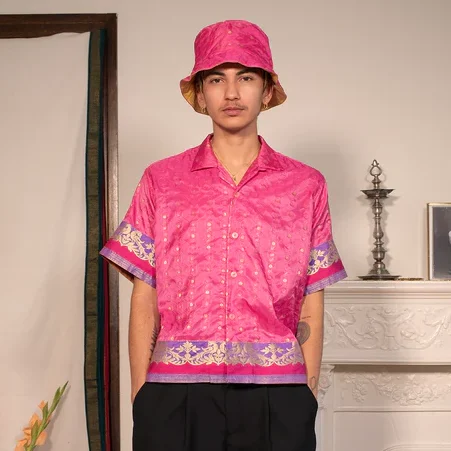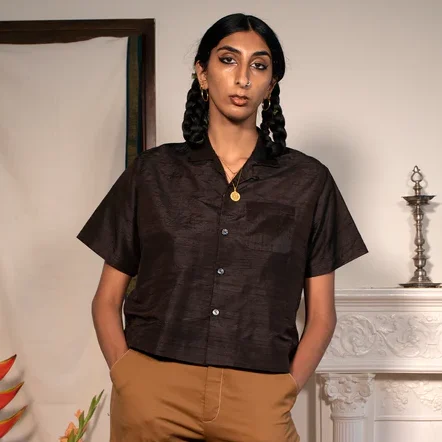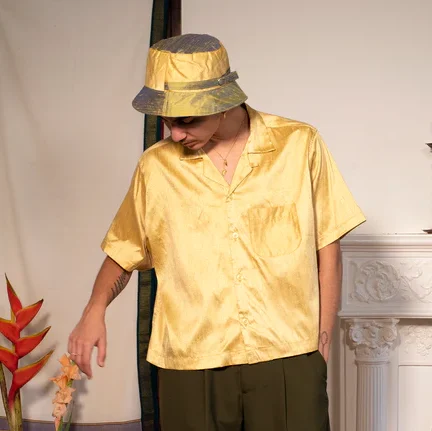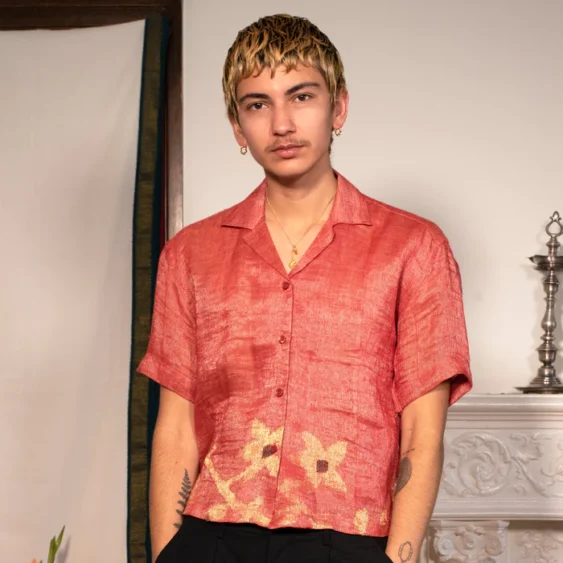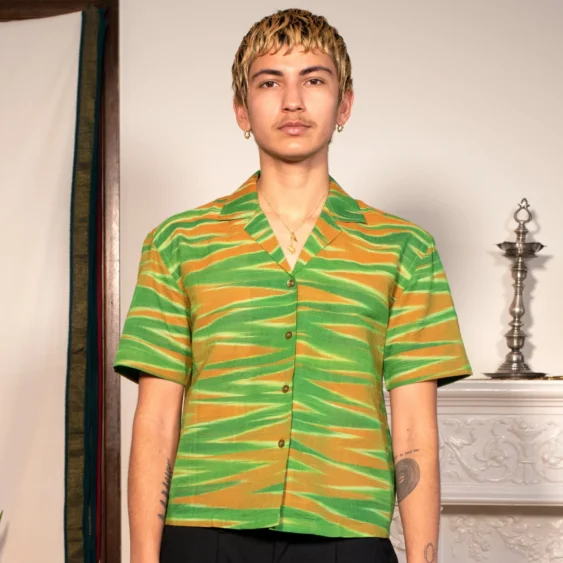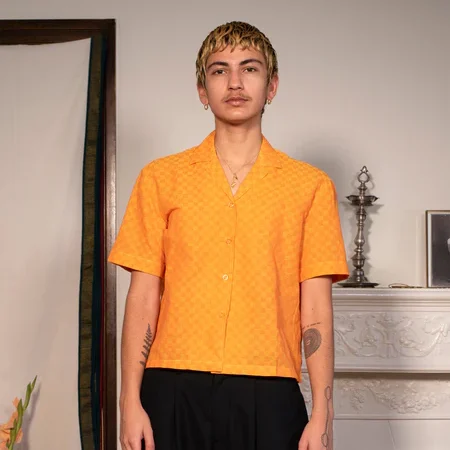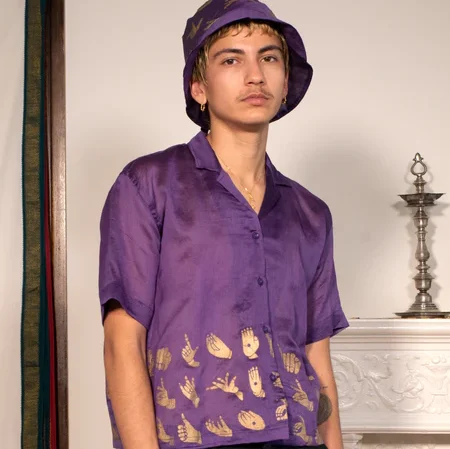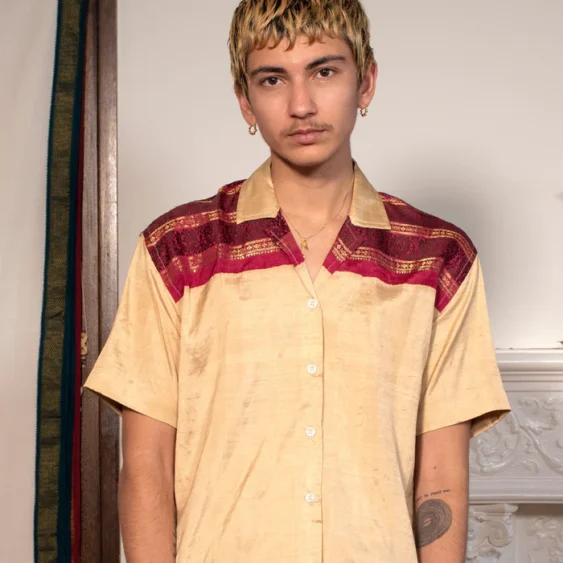

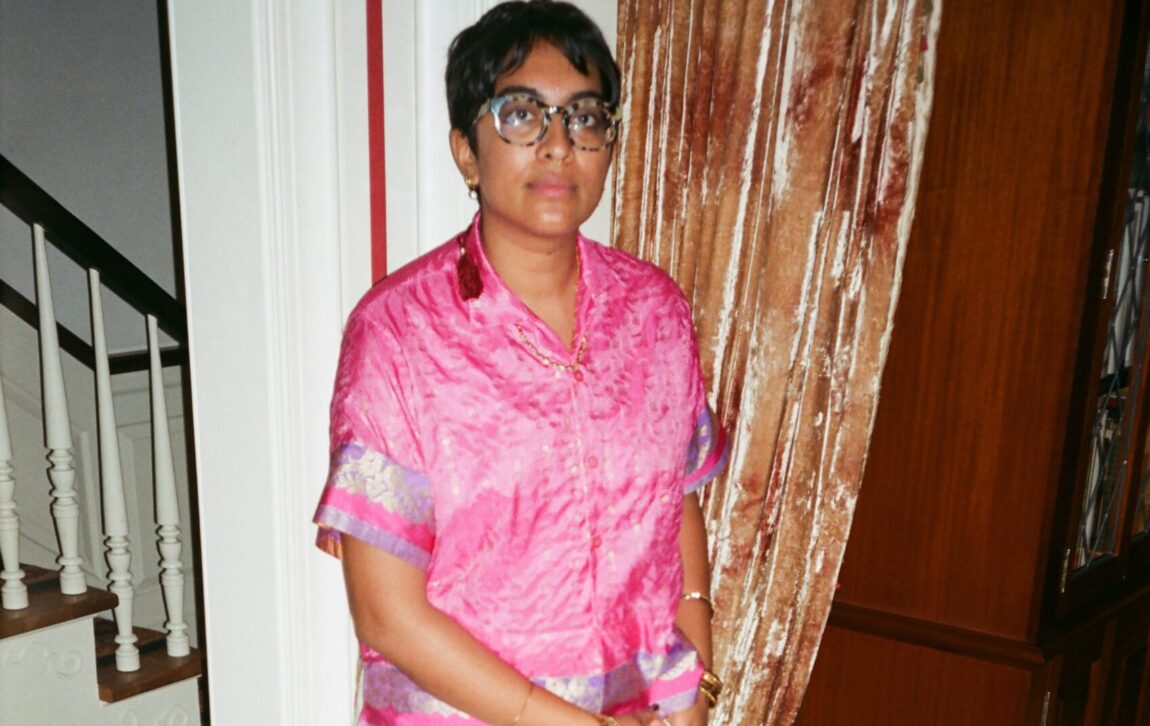
BRAND NAME - Samavai
FOUNDER - Shriya Samavai
STARTED IN - 2019
USP - Gender Affirming Fashion
Fueled by an upbringing rooted in the repurposing of garments and their own struggle to find outfits that aligned with their identity, Shriya Samavai founded Samavai, a label that is currently gaining popularity for its gender-affirming clothing. In the sprawling city of Los Angeles, Samavai is richly inspired by the legacy of South Asian textiles, especially those borrowed from vintage sarees, a traditional garment for women. Lending their exquisite weaves and surface techniques that date back a thousand years, these sarees transform into contemporary silhouettes that aim to explore the common ground between masculinity and femininity.
Shriya's Picks
Who is that one influencer or celebrity you wish to see wearing your garments?
Priya Ragu.

Is there a podcast, book, or social media handle that you’ve found helpful for your business?
I really enjoy The Cutting Room Floor which is a podcast about fashion and business hosted by the designer Recho Omondi.





If you could collaborate with an International designer or brand, who would it be?
Dries Van Noten.
BTB: What inspired you to start your brand?
SHRIYA: My experience as a design professional made me realize the impact of the fashion industry on the environment, the consumers, and garment labourers. Given my South Asian background and growing up exploring different types of sarees from various parts of India, I felt like there was so much that could be done with the fabric. Drawing from my experience of founding brands that repurposed and upcycled vintage leather and denim jackets, I decided to incorporate these concepts into Samavai - which I believe have traditionally sprung from financial limitations or the desire to own something from a different era. However, today, when we speak about thrifting, it intends to address environmental concerns.
BTB: What was the story behind naming your brands after your middle name?
SHRIYA: Samavai isn’t a traditional Tamilian surname, but my dad was captivated by the story of Queen Samavai from the Pallava dynasty in 966 CE. Eventually, when I was born, he chose ‘Samavai’ as my middle name. The name also has a strong connection to South India, where my roots lie and since my brand embodies so much about the culture, it made perfect sense to use it.
BTB: How did your brand come about addressing two extremely different aspects: gender affirmation and repurposing South Asian textiles?
SHRIYA: As a non-binary person, I have had a hard time finding formal clothes, especially ones that represent me. When I was younger, I wore traditional half-saris called ‘Pavadai Daavani’ in Tamil. I loved their colours and detail work but remember not liking their silhouettes and by puberty, I just didnt feel comfortable in them. The only option left was to wear the Veshti- a traditional menswear garment in South India. Considering that I wasn't out at the time, wearing that felt a bit unusual too. So, I felt like I was constantly being put into situations where I was uncomfortable and wanted something that could easily fit both genders.
I don't think there was a seed as such but in my subconsciousness, I got the idea of taking the saree material- that is so rich and woven in amazing fabrics and colours - and putting it into a silhouette that was accessible to people like me. I realized that it was a perfect crossover between masculinity and femininity. It also made me feel very close to my grandparents.
I loved the idea of taking my Patti’s saree and combining it with my Tattha’s silhouette(a classic short-sleeved button-down shirt). It also felt like men or people who dress masculinely were missing out by not interacting with the saree material that is generally reserved for women. So, that's where the concept of gender-affirming silhouettes and working with my heritage came from.
BTB: What is your professional background and what role did it play in getting your brand off the ground?
SHRIYA: I pursued art history and also did a business minor. Taking these two classes was significant in where I am right now-from understanding finances required to run a business to the kind of people I need to work with.
My professional experience has also contributed significantly. My first job at a small business was a perfect crash course on how to run your own business where I looked after everything from customer service, sending out orders, to photographing them. I have worked with Supreme for 4 years, where I learned a lot on branding and marketing and the meticulous attention to detail that was paid to production and quality because I don't have a formal training in fashion or design or production.
The last purchase you made from a homegrown brand?
Over the summer I got a beautiful hand-painted shirt by a brand called A Slow Future based in Oaxaca, Mexico.





What is that one book or song you are currently obsessing over?
I have been listening to a lot of Indian music lately, I love ghazals and sufis. Currently, I am also listening to Sid Sriram and Young Raja.
I am also reading a book by Joan Miro, a Spanish painter.





Name 2 homegrown brands that you are obsessing over right now.
Abacaxi by Sheena Sood
Imli dana
BTB: How do you measure the success of your business in terms of fulfilling your purpose within this niche?
SHRIYA: So many things. But, the opportunity to make custom garments for non-binary and South-Asian people, like I did earlier this year for a couple has been very fulfilling. I also recently got into my first store in Malibu, Los Angeles called Fred Segal which has been around since the 1960s which has been a huge affirmation.
BTB: How has the reception of South Asian textiles been in the United States?
SHRIYA: The people here in Los Angeles have been amazed at the quality of the saree fabric. Those who have never interacted with such textiles are over the moon with the kind of weaves each saree has - especially the sheerness of the organza fabric - which you don't really see much in the West. They have also been really mesmerized by the Indian motifs and the patterns that are very unique to the sarees, such as the gold peacocks, flowers, mangoes and more.
BTB: What does a typical 9-5 look like for you?
SHRIYA: Each day depends on the agenda for the week. Currently, I am also working part-time for a Los Angeles-based brand, while dedicating my time to Samavai. Usually, I spend a couple of hours responding to emails, and DMs on Instagram. And when I am not in the studio, I dedicate several hours to hands-on, non-computer tasks. Currently, I have been working on a patchwork project with leftover saree scrapes and practising marbling techniques on a vintage silk saree that I picked up from a warehouse in Los Angeles. But on some days, I am either dropping off film at the studio and working on some sewing work afterwards or photographing the garments for my look-book, going fabric sourcing in Los Angeles, or visiting our seamstress to deliver material or pick up samples.
BTB: Do you find it hard to take time out for yourself? How do you like to unwind?
SHRIYA: It can be challenging to switch your brain off when you're running your own business or engaging in a creative practice. Lately, though, I've been setting more boundaries, like avoiding screen time after a certain evening hour to prioritize my mental well-being. I visit the beach more often, spend time in my neighbourhood garden, and meet up with friends. Taking a walk is another great way to clear my mind. Occasionally, I visit the temple for a sense of peace and connection, where I get to hear people speaking my native language. Enjoying a variety of fruits is a significant part of my unwinding routine. In addition to that, I have been reading books about Van Gogh and Spanish painter, Joan Miro.
BTB: What are the challenges that you have faced and what have been your biggest takeaways from them?
SHRIYA: One of the biggest challenges is how expensive it is to have a business of your own while taking care of your expenses. Having to work another part-time job to sustain my business can get quite frustrating too. Currently, I have to rely on my family members living in the United States for most of the sourcing or wait for them to visit India to deliver the fabrics to the tailor. Overseeing production poses its challenges since 90% of the garments are manufactured in Chennai.
However, collaborations have played a significant role in my journey. I am grateful for having worked with so many models, different designers, and artists. Seeing my garments on people during photoshoots is immensely fulfilling. My college friends have also helped me design my website, investing the hours we needed to create the vision we had in mind.
BTB: What do you think the next five years look like for your business?
SHRIYA: I aim to diversify my product range beyond shirts and bucket hats, with my upcoming launch of a handbag range. I ultimately want to expand into formal-style clothing, especially suits. Introducing home goods like pillow covers, table runners, and tapestries, and incorporating marbling techniques into my collection would be good too, as getting into stores across the United States, Europe, and India. I also want the brand to sustain me full-time and would love to partner with artists, musicians, and performers to create custom stage outfits or costumes for their music videos too.
BTB: How have you balanced the influence of your cultural roots and your immigrant roots in your brand without letting one overpower the other so far?
SHRIYA: I find that my South Asian heritage has a stronger presence than my American side, because of our current branding and work with South Asian models. Because of this, we might be perceived exclusively as South Asians, which is not the case - Samavai is meant for everyone. I also want to diversify the concept of my brand, because I have received feedback from some non-South Asian individuals here who are concerned about cultural appropriation when wearing my garments. I don't believe they should feel that way because they are purchasing from a brand run by a South Asian who is very aware of the brand's presence in two different cultural spaces simultaneously.
BTB: What is that one repurposing ritual in your family that you have retained in your life?
SHRIYA: My parents have always taken really good care of their clothes and my mother has a strong inclination towards upcycling. I grew up with this concept of making your clothes last longer and exploring ways to transform them into something new before getting rid of them. Many of our household practices, like playing the Suprabhatam every morning and offering food to the divine, are deeply ingrained in me, even though I haven't been able to keep up with them as diligently as my parents. But, I do love how grounding the rituals are, and despite my living away from India, they keep me rooted in my cultural heritage and connected to my family there.
FOLLOW SAMVAI'S INSTAGRAM @samavai.world
